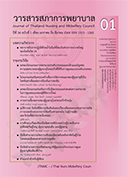Effects of Self-Efficacy-Promoting Programme on Self-Care Ability of Persons with Stoma
Keywords:
self-effcacy-promoting programme, self-care ability, stomaAbstract
Objective: To compare the self-effcacy and self-care ability of persons with stoma, before and after receiving a self-effcacy-promoting programme
Design: Two-group quasi-experimental research with a pretest and a posttest
Methodology: The subjects of the study were 57 patients who, by prior appointment, received permanent stoma surgery. After being recruited by means of simple random sampling, 29 of the patients were assigned to the control group, which received standard care, whilst the other 28 were assigned to the experimental group, which was given the self-effcacy promoting programme. Data gathering was conducted using a personal information record form, the Stoma Self-Effcacy Scale, and the Stoma Self-Care Ability Scale. Descriptive statistics and t-test were employed for data analysis.
Results: First, the experimental group’s post-intervention perceived self-effcacy score was signifcantly higher than its pre-intervention score (by p < 0.05), and signifcantly higher than that of the control group (by p< 0.05). Second, the experimental group scored signifcantly higher on self-care ability than the control group did (by p <0.05).
Recommendations: It is recommended that nurses and healthcare teams implement this self-effcacy promoting programme to promote self-effcacy and self-care ability in stoma surgery patients, in the pre-operative, post-operative, and post-discharge stages.
Downloads
References
Wannawong S. Stoma care. In: Boonpipattanapong T, Wanwong S, editors. Wound and stoma care. Songkhla: Chanmuangkanpim; 2010. p. 55-76. (in Thai)
Pripattananon C. Urinary diversion operation and care. In: Boonpipattanapong T, Wanwong S, editors. Wound and stoma care. Songkhla: Chanmuangkanpim; 2010. p. 31-54. (in Thai)
United Ostomy Associations of America (UOAA). Living with an ostomy [Internet]. 2020 [cited 2020 October 27]. Available from: https://www.ostomy.org/living-with-an-ostomy.
McGee MF. Stomas. JAMA 2016;315:2032.
Department of Medical Record and Statistics. Data of Patients with Stoma Operation in 2019. Bangkok: King Chulalongkorn Memorial Hospital; 2019. (in Thai)
Grant M, McCorkle R, Hornbrook MC, Wendel CS, Krouse R. Development of a chronic care ostomy self-management program. J Cancer Educ 2013;28(1):70-8.
Herlufsen P, Olsen AG, Carlsen B, Nybaek H, Karlsmark T, Laursen TN, et al. Study of peristomal skin disorders in patients with permanent stomas. Br J Nurs 2006;15:854-62.
Burch J. Management of peristomal skin complications. Br J Health Manage 2014;20:264-9.
Wannawong S, Isaramalai S, Kahawong W. Development and evaluation of program for supporting and enhancing care agency on complication prevention among ostomates. The 12th Graduate Research Conference Khon Kaen University, January 28, 2011; 852-61. (in Thai)
Chaleoykitti S, Poonchai S, Sawangchit S, Bandansin J. The way of life among patients with colostomy. The Royal Thai Army Nurses 2013;14(3):31-8. (in Thai)
Bandura A. Self-effcacy: the exercise of control. New York: W.H. Freeman; 1997.
Jayarajah U, Samarasekera DN. A cross-sectional study of quality of life in a cohort of enteral ostomy patients presenting to a tertiary care hospital in a developing country in South Asia. BMC Research Notes 2017;10(1):75.
Pittman JA. Ostomy complication and associated risk factors: development and testing of two instruments [dissertation]. Bloomington: Indiana University; 2011.
Chaudhri S, Brown L, Hassan I, Horgan AF. Preoperative intensive, community-based vs. traditional stoma education: a randomized, controlled trial. Dis Colon Rectum 2005;48:504-9.
Pandey RA, Dhungana SB. Knowledge and practice of stoma care among ostomates at B. P. Koirala Memorial Cancer hospital. Journal of Nobel Medical College 2015;4(1):36-45.
Prasangsit C. Nursing care of patient with colorectal cancer. In: Prasangsit C, Rungsangchan K, Editors. Enterostomal nursing care: experience from experts. Bangkok: Quality Development Nursing Division, Department of Nursing, Faculty of Medicine Siriraj Hospital, Mahidol University; 2015. p. 1-12. (in Thai)
Danielsen AK, Soerensen EE, Burcharth K, Rosenberg J. Learning to live with a permanent intestinal ostomy: impact on everyday life and educational needs. J Wound Ostomy Continence Nurs 2013;40:407-12.
Kim KM, Baek ES, Kang NH, Yoon KE, Bae NY, Cha BK. Effects of self effcacy promoting programs on self effcacy, self care behavior and psychosocial adaptation in patients with a colostomy. J Korean Acad Fundam Nurs 2007;14:288-96.
Cohen J. Statistical power analysis for the behavioral sciences. New York: Academic Press; 1977.
Polit DF, Beck CT. Nursing research: generating and assessing evidence for nursing practice 10th ed. Philadelphia: Wolters Kluwer; 2017.
Teerathongdee K, Ronnarithivichai C, Thongchareon V, Pongthavornkamol K. Factors predicting quality of life in older adult patients with colorectal cancer post stomal surgery. Thai Cancer J 2014;34(2):68- 78. (in Thai)
Cheng F, Xu Q, Dai XD, Yang LL. Evaluation of the expert patient program in a Chinese population with permanent colostomy. Cancer Nurs 2012;35(1):e27-33.
Zhang JE, Wong FK, You LM, Zheng MC, Li Q, Zhang BY, et al. Effects of enterostomal nurse telephone follow-up on postoperative adjustment of discharged colostomy patients. Cancer Nurs 2013;36:419-28.








